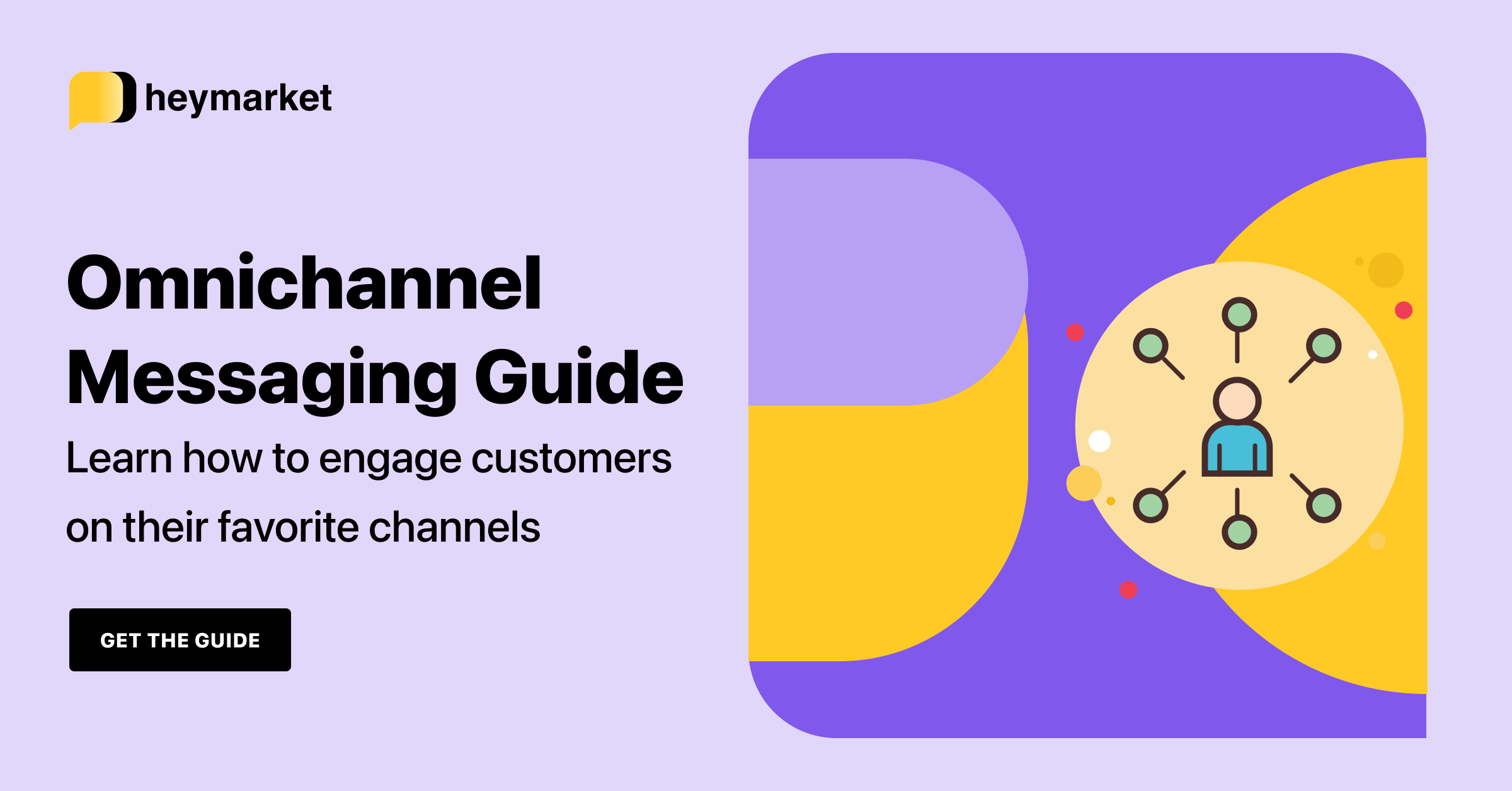
Omnichannel messaging channels—like Apple Messages for Business, Google’s Business Messages, Facebook Messenger, and WhatsApp—are making it easier than ever for you to connect with leads and customers.
With help from a business texting solution, you can even receive messages from all omnichannel providers in a single shared inbox. You can quickly access all customer requests and queries in a centralized location.
But what’s the difference between these channels? How can you use them to engage with your leads?
Let’s dive in.

Want to learn more about engaging with customers on their favorite channels? Check out our Omnichannel Messaging Guide.
Get the GuideApple Messages for Business and Google’s Business Messages
Apple Messages for Business and Google’s Business Messages are similar in many ways. Apple Messages for Business lets customers message your business directly from their iPhone, Mac, or Apple Watch. Google’s Business Messages allows leads to reach your business through local search in Google Maps, Google search, answer cards on Google, or a Google widget on your website. Both channels allow you to brand your messaging interface and use rich tools, like in-channel slideshows, to enhance the messaging experience.
These channels have particular rules for engaging with leads. Your team:
- Must enable your brand and activate the channel. Leads will not be able to connect with your business through either channel unless your brand is approved by Apple and Google and activates the channels first.
- May only chat with leads who have reached out first. This rule is the same across every omnichannel messaging channel. It’s incredibly important to ensure a great customer experience and reduce spam. With Apple Messages for Business and Google’s Business Messages, there isn’t a way for your agents to contact leads who haven’t messaged first.
- Can not reconnect with leads who end conversations. If a customer texts in with a question and opts into your business text messaging service, you are allowed to follow up with them. It’s a little different with Apple Messages for Business or Google’s Business Messages. If a lead finishes a conversation and deletes it, your agents may not message them again.
- Should send immediate auto replies to each lead. Leads expect a smooth, fast messaging experience. Send customers auto replies as soon as they text in. During business hours, include expected reply times in your auto reply. After business hours, list your hours of operation, too.
Other than these four particularities, best practices for Apple Messages for Business and Google’s Business Messages are similar to those of other messaging channels. Be prompt, write short and clear messages, and use a positive tone where possible.
Facebook Messenger
Facebook Messenger is a critical tool for lead acquisition. Over 60 million businesses have Pages. Many leads check out businesses’ Facebook pages before they make purchases. Facebook Messenger lets them reach out to you with quick questions.
Facebook Messenger has four guidelines to follow when communicating with leads. Your team:
- Must create a Facebook Page. Leads can’t message your business through Facebook Messenger unless you’ve created a Facebook Page. Once you’ve created a Page, they can easily message your team.
- May only chat with leads who have reached out first. Again, this is a critical rule with any messaging channel. Like Apple Messages for Business and Google’s Business Messages, there is no way for your team to connect with leads who haven’t messaged your team first through Facebook Messenger.
- Can reconnect with leads who end conversations. Facebook Messenger allows your team to reach back out to leads as long as it’s within a twenty-four hour period. Ensure that your agents only use this feature to follow up on tickets or in-app purchases. Do not use this tool to push sales or offer coupons.
- Should send immediate auto replies to each lead. You want the Facebook Messenger experience to be as smooth as possible. Like with Apple Messages for Business and Google’s Messages, send leads during-hours and after-hours auto replies. Consider using the same auto reply for each channel for branding continuity.
For the most part, using Facebook Messenger to connect with leads is similar to using Apple Messages for Business or Google’s Business Messages. The biggest difference is that your team can use the channel to follow up with leads after conversations are complete.
WhatsApp is a popular messaging channel across the world. Consumers use it to chat with friends, family, and their favorite brands. Your leads can chat with you if your number is saved onto their phone or they can reach out to you after viewing your business profile.
WhatsApp is similar to Facebook Messenger when it comes to communicating with leads. Your team:
- Must create a WhatsApp business profile. Your business needs to create a WhatsApp account before leads can contact your team. They can easily message your team after you’ve formed one.
- May chat with leads who have saved your number. The Broadcast tool empowers your team to send messages to leads who have saved your number in WhatsApp. This allows you to reach many leads at once. Because they’ve already saved your number, they’re likely to read and appreciate your content, especially conversational marketing content.
- Can reconnect with leads who end conversations. Like Facebook Messenger, WhatsApp allows your team to reconnect with leads who already chatted with your team once. Agents should only use this feature to follow up for customer service purposes, not marketing or sales.
- Should send immediate auto replies to each lead. Again, the messaging experience should be smooth no matter which channel leads use. Send leads the same during-hours and after-hours auto replies that you use for other channels. This ensures branding continuity.
Compared to the other three omnichannel channels above, WhatsApp is most like business text messaging. Like with Facebook Messenger, you can reconnect with leads who end conversations. But your team can also reach out to those who have saved your number.
Want to learn more about engaging with customers across all popular messaging channels? Read our omnichannel messaging guide.





